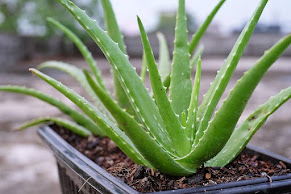MEDICINAL PLANT
1. Aloe Vera
Aloe vera is a versatile and popular medicinal plant known for its many health benefits, especially in skincare and digestive health. Aloe vera is a succulent plant with thick, fleshy, and spiky leaves.The inner part of the leaf contains a clear gel, which is used for its medicinal properties, while the outer leaf layer contains latex (a yellowish substance).
Scientific Name: Aloe barbadensis millerFamily: AsphodelaceaeCommon Names: Aloe, Aloe Vera, Lily of the DesertNative to: Northern Africa, but now widely cultivated in tropical and subtropical regions around the world Medicinal Uses of Aloe Vera:-
Aloe vera has a wide range of uses, especially for its skin and digestive benefits.
Burns and Sunburns, Wound Healing, Moisturizer, Acne, Anti-aging.
2. Digestive Health
Constipation, Soothing the Digestive Tract, Irritable Bowel Syndrome (IBS).
3. Immune Support
Anti-inflammatory and Antioxidant Effects, Blood Sugar Regulation.
4. Oral Health
Mouth Ulcers and Gum Health, Toothpaste.
Nutritional Profile:-
Aloe vera gel contains several important vitamins and minerals that contribute to its health benefits:
- Vitamins: A, C, E, B12, folic acid
- Minerals: Calcium, magnesium, zinc, potassium
- Amino Acids: Contains 20 of the 22 essential amino acids, including all 8 essential ones.
- Enzymes: Including amylase and lipase, which assist in the digestion of sugars and fat.
2. Tulsi
Tulsi (also known as Holy Basil, Ocimum sanctum) is an aromatic herb that has been revered in Indian culture for thousands of years, not only for its culinary uses but also for its profound medicinal properties. Often called the "Queen of Herbs" in Ayurveda, Tulsi is considered sacred in Hinduism and is believed to have a variety of health benefits.
Scientific Name: Ocimum sanctum (also known as Ocimum tenuiflorum)Common Names: Holy Basil, Tulsi, Sacred Basil, Queen of HerbsFamily: Lamiaceae (Mint family)Native to: India and Southeast Asia
Medicinal Uses of Tulsi:-
Tulsi has a long history of use in traditional medicine, especially in Ayurveda, where it is considered an adaptogen (a substance that helps the body cope with stress) and a powerful herb for maintaining overall wellness.
1. Stress Reduction and Adaptogenic Properties
2. Immune System Boost
3. Anti-inflammatory and Pain Relief
4. Respiratory Health and Cough Relief
5. Blood Sugar Control
6. Antioxidant and Anti-aging
7. Digestive Health
8. Skin Health
Safety and Precautions:-
Pregnancy and Breastfeeding: Tulsi is generally considered safe for most people, but pregnant or breastfeeding women should consult with a healthcare provider before using Tulsi, as it may have hormonal effects.
Blood Thinners and Surgery: Tulsi may act as a natural blood thinner, so it should be avoided before surgery or if you are taking blood-thinning medications (e.g., warfarin).
Allergies: Some people may be allergic to Tulsi. If you experience any rash, itching, or difficulty breathing after using Tulsi, discontinue use and consult a healthcare professional.
Benefits of Tulsi:-
- Reduces stress and anxiety (Adaptogen).
- Boosts immunity and helps fight infections.
- Reduces inflammation and relieves pain.
- Supports respiratory health (coughs, asthma, bronchitis).
- Helps regulate blood sugar levels.
- Antioxidant and anti-aging benefits.
- Improves digestion and gut health.
- Promotes healthy skin and healing.
3. Peppermint
Peppermint (Mentha × piperita) is a hybrid plant that results from the cross between watermint (Mentha aquatica) and spearmint (Mentha spicata). It has been used for centuries for its medicinal properties and is popular in both traditional and modern herbal medicine.
The scientific name of peppermint is Mentha × piperita.
- Mentha refers to the genus of the mint family, which includes many other species of mint.
- × piperita indicates that peppermint is a hybrid plant, specifically a cross between Mentha aquatica (watermint) and Mentha spicata (spearmint).
Medicinal Uses of Peppermint:-
1.Digestive Health
2.Relieving Headaches and Migraines
3.Respiratory Health
4.Pain Relief
5.Skin Health
6.Mood and Stress Relief
Active Compounds in Peppermint:-
The therapeutic effects of peppermint come primarily from its active compounds, particularly menthol and menthone. Here’s a closer look at some of the key compounds:
Menthol:
- This compound is responsible for peppermint’s cooling sensation. It has analgesic, antispasmodic, and decongestant properties, making it effective for headaches, digestive issues, and respiratory relief.
Menthone:
- Another important compound, menthone has a more subtle, soothing effect and contributes to peppermint’s calming and digestive benefits.
Flavonoids:
- Peppermint contains several flavonoids (e.g., luteolin, apigenin), which are antioxidants that help reduce inflammation and protect the body from oxidative stress.
Tannins:
- These compounds have astringent properties that help soothe irritated tissues, especially in the digestive and respiratory tracts.
Rosmarinic Acid:
- Known for its anti-inflammatory and antioxidant effects, rosmarinic acid in peppermint helps reduce inflammation, making it useful in treating conditions like IBS and other inflammatory issues.
Precautions and Side Effects:-
While peppermint is generally considered safe for most people, there are some precautions to keep in mind:
Skin Sensitivity: Peppermint oil should be diluted before applying to the skin. It can cause irritation or a burning sensation if used undiluted.
Gastroesophageal Reflux Disease (GERD): In some people, peppermint may relax the lower esophageal sphincter, potentially leading to acid reflux or heartburn. If you have GERD, it's best to consult with a healthcare provider before using peppermint.
Pregnancy and Breastfeeding: Peppermint is generally considered safe in food amounts during pregnancy and breastfeeding, but high doses of peppermint oil or supplements should be avoided unless directed by a healthcare provider.
Children: Peppermint oil should not be used on children under two years of age, as it can cause respiratory distress. Always consult with a pediatrician before using peppermint for young children.
#PEPPERMINT#TULSI#ALOE VERA#LEAF#USES#NUTRITIONAL VALUE#SAFETY#PRECAUTIONS#SIDE EFFECTS#SCIENTIFIC NAME#MEDICINAL PLANT
sponcership
"This Content Sponsored by Genreviews.Online
Genreviews.online is One of the Review Portal Site
Website Link: https://genreviews.online/
Sponsor Content: #genreviews.online, #genreviews, #productreviews, #bestreviews, #reviewportal"









